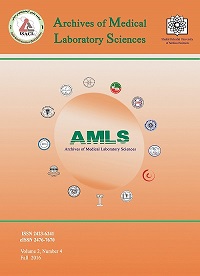The Correlation Between SMG1 Promoter Methylation and Its Expression in Acute Lymphoblastic Leukemia Patient
Archives of Medical Laboratory Sciences,
Vol. 2 No. 4 (2016),
16 April 2017,
https://doi.org/10.22037/amls.v2i4.16247
Background: Acute lymphoblastic leukemia (ALL) comprises a heterogeneous group of disorders which originate from various important genetic lesions in B and T progenitor cells, including mutations that lead to stage-specific developmental arrest and those that impart the capacity for unlimited self-renewal, resulting in clonal expansion of immature progenitor cells. Acute lymphoblastic leukaemia occurs in both children and adults but its incidence peaks between 2 and 5 years of age. Causation is multifactorial and exogenous or endogenous exposures, genetic susceptibility, and chance have roles. Survival in pediatric acute lymphoblastic leukaemia has improved to roughly 90% in trials with risk stratification by biological features of leukaemic cells and response to treatment, treatment modification based on patients' pharmacodynamics and pharmacogenomics, and improved supportive. The promoter methylation pattern of DNA in cancer cells is different with the normal cells. Suppressor with morphogenetic effect on genitalia family member (SMG1) belongs to a family of phosphoinositide 3-kinase-related kinases and is the main kinase involved in nonsense-mediated mRNA decay.
Materials and Methods: This study was performed to investigate the correlation between SMG1 promotor methylation and its expression levels in acute lymphoblastic leukemia using methylation specific PCR (MSP). Our patients and control samples were collected from Children's Medical Center of children medical center of Imam Khomeini hospital of Tehran. To confirm the MSP results, we used Quantitative Real time-PCR (qRT-PCR ) to measure the expression level of mRNA to find out if there is any relation between pattern of methylation and expression.
Results: After performing MSP, we found that SMG1 promoter was hypermethylated. Hyper methylation of SMG1 was detected in 67/74% (21/31) of ALL samples compared to control group. SMG1 mRNA expression was down- regulated 2.74 fold compared to control group.
Conclusion: The aim of this study was to investigate the effect of methylation pattern on gene expression. Our findings suggest that SMG1 acts as a functional tumor suppressor gene which was down-regulated by CpG islands hypermethylation in ALL patients. It was shown that the methylation of SMG1 was occurred in the 67/74% of samples.
